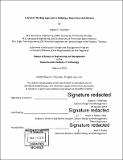| dc.contributor.advisor | Bryan R. Moser. | en_US |
| dc.contributor.author | Thornton, Robert F.(Robert Francis) | en_US |
| dc.contributor.other | Massachusetts Institute of Technology. Engineering and Management Program. | en_US |
| dc.contributor.other | System Design and Management Program. | en_US |
| dc.date.accessioned | 2019-07-18T20:30:39Z | |
| dc.date.available | 2019-07-18T20:30:39Z | |
| dc.date.copyright | 2019 | en_US |
| dc.date.issued | 2019 | en_US |
| dc.identifier.uri | https://hdl.handle.net/1721.1/121801 | |
| dc.description | Thesis: S.M. in Engineering and Management, Massachusetts Institute of Technology, System Design and Management Program, 2019 | en_US |
| dc.description | Cataloged from PDF version of thesis. | en_US |
| dc.description | Includes bibliographical references (pages 87-89). | en_US |
| dc.description.abstract | The United States military services, government, and civilian population rely on the US military's historic technical dominance in outer space. Space-enabled capabilities have become fundamental across the spectrum of military and civilian activities. The space superiority gap that the US military has held for decades is narrowing as access to space technology, and to space itself, becomes more widespread, allowing more nations, private industry, and non-state actors to become significant players in space. In response to this trend, the US Department of Defense and Congress are seeking to establish the Space Force as an independent branch of the Armed Forces. This thesis applies a systems thinking method to designing the structure and function of the Space Force. Through review of open-source literature, the study summarizes the current state of the military space enterprise and assesses the arguments made by advocates of various approaches to organizing the space forces. | en_US |
| dc.description.abstract | The US military possesses extensive space power, executing critical missions such as navigation, imagery, and communications. US government space functions also include space intelligence, managing space traffic, and regulating the space industry. The literature review enables understanding of the existing architecture, five proposed alternative architectures and the eight key decisions on which they are based, and eight utility and cost metrics for evaluating the options. Tradespace analysis reveals the relative value of the six architectures and how they compare to other possible configurations to inform the Space Force debate. This limited investigation expressly does not include classified information or insider perspectives, and therefore does not offer policy recommendations, but within its limitations and assumptions the tradespace analysis offers some useful conclusions. | en_US |
| dc.description.abstract | First, creating the Space Force as a separate branch of the military is consistent with national security priorities and the current circumstances of the military and industry. Second, making the Space Force a whole-of-government organization yields the highest utility, though at the highest cost, amongst the six architectures under consideration. Third, military space capability commercialization can allow reduced cost and improved utility compared to the current architecture. Finally, consolidated space acquisitions only, without additional steps toward a separate Space Force, might not improve the military space enterprise compared to the existing baseline. Recommendations for future study include incorporating classified data and key stakeholder input into the framework, further decomposing the military space functions to elaborate the tradespace in greater detail and defining criteria for commercialization of space capabilities. | en_US |
| dc.description.abstract | These additional steps will enable the research to reliably inform policy decisions. | en_US |
| dc.description.statementofresponsibility | by Robert F. Thornton. | en_US |
| dc.format.extent | 91 pages | en_US |
| dc.language.iso | eng | en_US |
| dc.publisher | Massachusetts Institute of Technology | en_US |
| dc.rights | MIT theses are protected by copyright. They may be viewed, downloaded, or printed from this source but further reproduction or distribution in any format is prohibited without written permission. | en_US |
| dc.rights.uri | http://dspace.mit.edu/handle/1721.1/7582 | en_US |
| dc.subject | Engineering and Management Program. | en_US |
| dc.subject | System Design and Management Program. | en_US |
| dc.title | A systems thinking approach to defining a space force architecture | en_US |
| dc.type | Thesis | en_US |
| dc.description.degree | S.M. in Engineering and Management | en_US |
| dc.contributor.department | Massachusetts Institute of Technology. Engineering and Management Program | en_US |
| dc.identifier.oclc | 1103606960 | en_US |
| dc.description.collection | S.M.inEngineeringandManagement Massachusetts Institute of Technology, System Design and Management Program | en_US |
| dspace.imported | 2019-07-18T20:30:36Z | en_US |
| mit.thesis.degree | Master | en_US |
| mit.thesis.department | SysDes | en_US |
